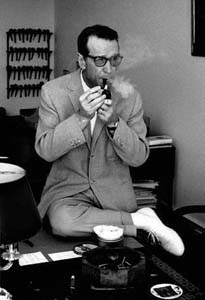George Simenon
| Georges Simenon | |
|---|---|

1963
|
|
| Born | Georges Simenon 13 February 1903 Liège, Belgium |
| Died | 4 September 1989 (aged 86) Lausanne, Switzerland |
| Occupation | Novelist |
| Notable awards | Académie royale de Belgique (1952) |
Georges Joseph Christian Simenon (French: [ʒɔʁʒ simnɔ̃]; 13 February 1903 – 4 September 1989) was a Belgian writer. A prolific author who published nearly 500 novels and numerous short works, Simenon is best known as the creator of the fictional detective Jules Maigret.
Georges Simenon was born at 26 rue Léopold (now number 24) in Liège to Désiré Simenon and his wife Henriette. Désiré Simenon worked in an accounting office at an insurance company and had married Henriette in April 1902. Although Georges Simenon was born on Friday 13 February 1903 superstition resulted in his birth being registered as having been on the 12th. This story of his birth is recounted at the beginning of his novel Pedigree.
The Simenon family traces its origins back to the Limburg region, his mother's family being from Dutch Limburg. His mother had origins from both the Netherlands and Germany while his father was of Walloon origins. One of her more notorious ancestors was Gabriel Brühl, a criminal who preyed on Limburg from the 1720s until he was hanged in 1743. Later, Simenon would use Brühl as one of his many pen names.
In April 1905, two years after Georges Simenon's birth, the family moved to 3 rue Pasteur (now 25 rue Georges Simenon) in Liège's Outremeuse neighborhood. Georges Simenon's brother Christian was born in September 1906 and eventually became their mother's favorite child, much to Georges Simenon's chagrin. Later, in February 1911, the Simenons moved to 53 rue de la Loi, also in the Outremeuse. In this larger home, the Simenons were able to take in lodgers. Typical among them were apprentices and students of various nationalities, giving the young Simenon an important introduction to the wider world; this marked his novels, notably Pedigree and Le Locataire.
At the age of three, Simenon learned to read at the Saint-Julienne nursery school. Then, between 1908 and 1914, he attended the Institut Saint-André. In September 1914, shortly after the beginning of the First World War, he began his studies at the Collège Saint-Louis, a Jesuit high school.
...
Wikipedia
